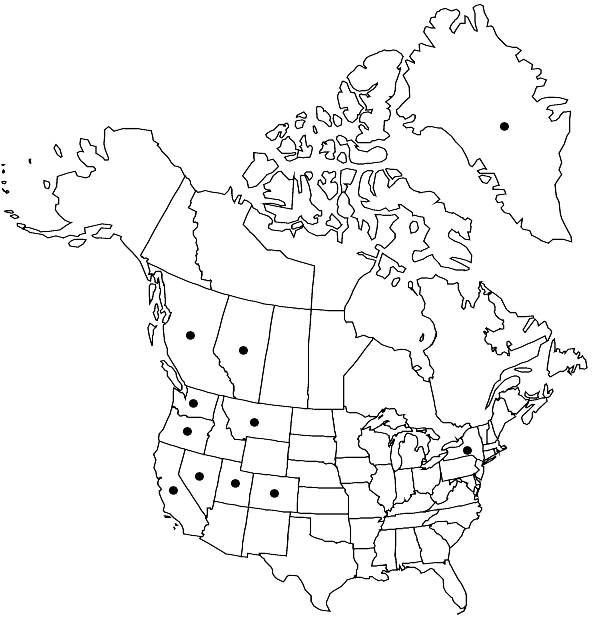Grimmia caespiticia
Laubm. –Fl. Oesterr.-Ung., 172. 1882,.
Plants in dense flat mats, blue-green to black-green. Stems 0.5–1 cm, central strand weak. Leaves lanceolate from a broad base, 0.8–1.3 × 0.2–0.5 mm, keeled, weakly to rarely strongly plicate distally [often strongly plicate in Eurasian specimens], margins plane proximally, incurved distally, cucullate, awn 0.1–0.5 mm, often muticous, costal transverse section prominent, semicircular; basal juxtacostal laminal cells quadrate to short-rectangular, straight, thin-walled; basal marginal laminal cells short- to long-rectangular, straight, thick transverse and thin lateral walls, not hyaline; medial laminal cells rounded-quadrate, thick-walled; distal laminal cells 2-stratose, bulging, marginal cells 2-stratose, bulging. Sexual condition dioicous, perichaetial leaves not enlarged. Seta straight, 1.8–2.4 mm. Capsule occasionally present, exserted, yellow, cylindric, exothecial cells short-rectangular, thin-walled, stomata present, annulus of 1 row of quadrate, thick-walled cells, operculum mammillate, peristome present, fully-developed, solid in distal half.
Habitat: Exposed, dry to moist, acidic granite and quartzite, alpine
Elevation: moderate to high elevations (1200-3500 m)
Distribution

Greenland, Alta., B.C., Calif., Colo., Mont., Nev., N.Y., Oreg., Utah, Wash., Eurasia.
Discussion
Grimmia caespiticia is an uncommon species that occurs on siliceous rock outcrops above timberline in western North America. J. Muñoz (1998b) reported the species on dry rock, but H. C. Greven (1995) cited it as being hygrophytic. Hastings has observed specimens most commonly in moist areas, but occasionally also on dry rock. Grimmia caespiticia does not occupy sites as extreme as those of G. sessitana, being found at somewhat lower latitude and elevations. Except for a single site in New York state, it is not known from east of the front ranges of Colorado. Grimmia caespiticia and G. elongata are the only members of the Montanae group (in the sense of Muñoz) to be both dioicous and have stomata. Grimmia caespiticia typically has a cucullate leaf apex, a feature unknown in other members of the Montanae group and very rare in Grimmia. For most North American specimens, the cucullate apex is more easily seen than are the leaf plications. While usually present, the plications are often not evident except in transverse section. Eurasian specimens typically have, however, strongly developed plications. Most specimens of G. caespiticia have been misidentified as G. alpestris. These two species are similar in habit, have ovate leaves with incurved margins, may have bulging laminal cells, and are dioicous. However, G. caespiticia has stomata while G. alpestris has none. If a specimen has a cucullate leaf apex and/or the plications are well-developed in transverse section then it is most certainly G. caespiticia.
Grimmia caespiticia may also be confused with G. sessitana. These species are both found above timberline and both have bulging laminal cells and capsules with stomata. However, the incurved leaf margins, cucullate apex, and quadrate to short-rectangular basal areolation of G. caespiticia are quite different from the plane to recurved leaf margins with long-rectangular basal areolation typical of G. sessitana. Although the type specimen of G. alpestris var. holzingeri lacks capsules, gametophytically it is indistinguishable from muticous specimens of G. caespiticia. Specimens of var. holzingeri with capsules have been collected near the type locality and these specimens have stomata. Rather than accepting that G. alpestris may have stomata (in the sense of E. Lawton 1971), Hastings places var. holzingeri within the concept of G. caespiticia. In 1890, Kindberg described G. nivalis based on a specimen collected by J. Macoun at a high elevation site in southern British Columbia. This taxon is similar to G. caespiticia, differing mainly by having papillae on the leaf lamina. Having examined the type and other material of G. nivalis, Hastings interprets these features to be merely the remnants of laminal cell walls; the exterior surface of the strongly bulging cell wall has been worn away by the elements. H. C. Greven (2003) believed that the somewhat longer awns and weak plications of G. nivalis fit well with European specimens of G. pyrenaica, a taxon that has also been put in synonymy with G. caespiticia. Therefore, we place G. nivalis in synonymy with G. caespiticia.
Selected References
None.